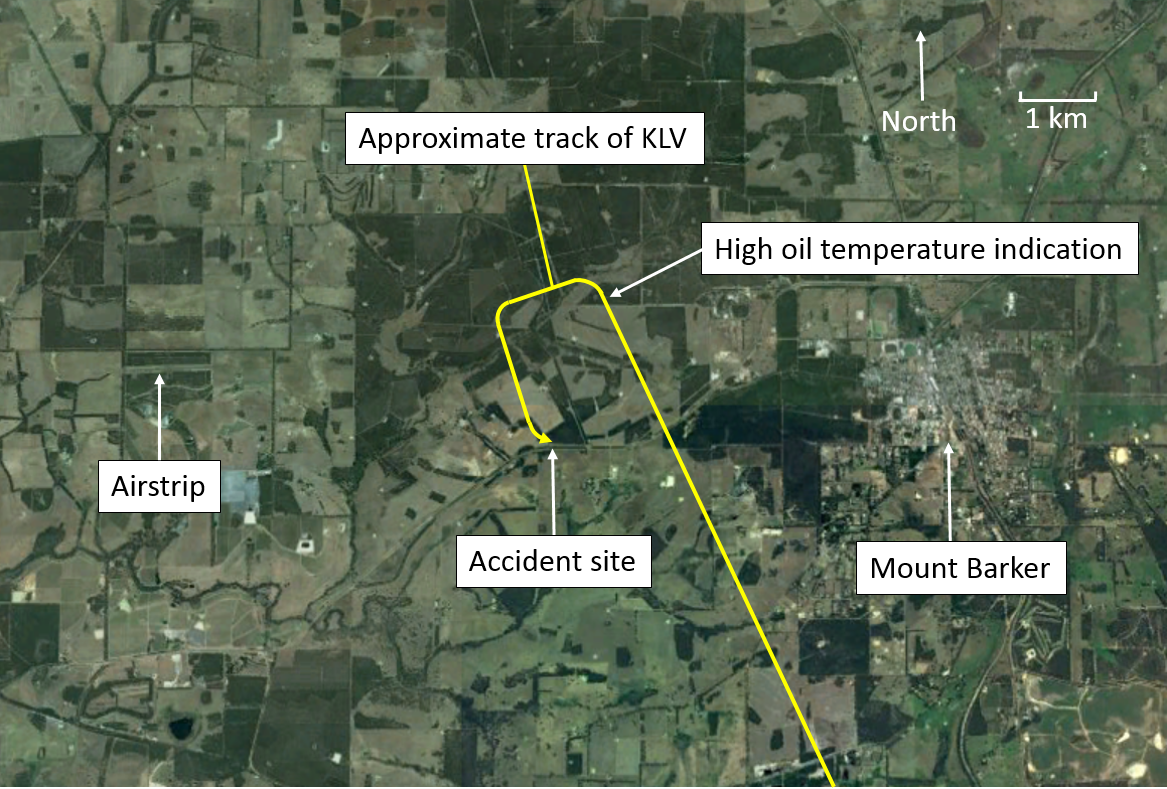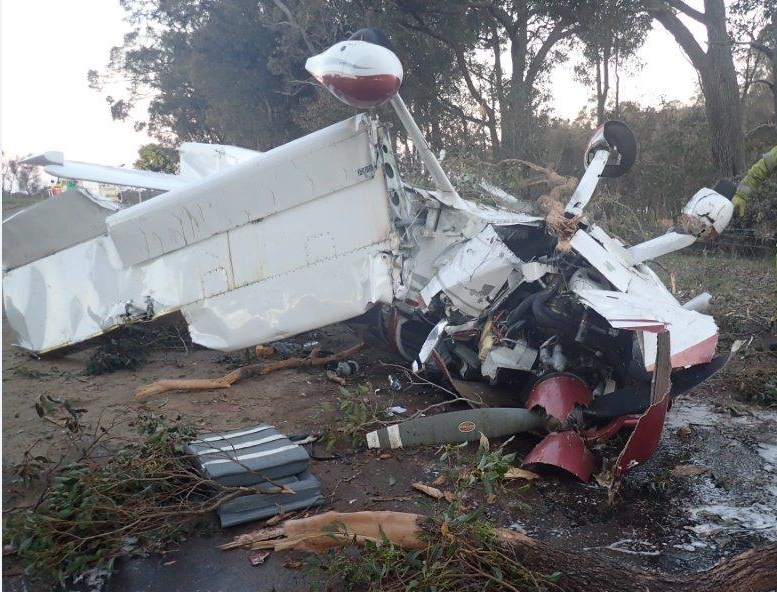What happened
On 4 September 2016, at about 1655 Western Standard Time (WST), an amateur-built Van’s RV-9A aircraft registered VH-KLV (KLV), departed Albany Airport, Western Australia (WA), for a flight to Jandakot Airport, WA. On board the private flight were a pilot and one passenger.
About 15 minutes into the flight, the aircraft was north-west of Mount Barker and climbing through about 4,000 ft. At this time, the pilot observed an oil temperature indication greatly exceeding the normal operating limit, all other engine indications appeared normal. The pilot immediately reduced power to idle and turned the aircraft towards an airstrip to the west of Mount Barker (Figure 1). As the aircraft descended through about 2,500 ft, the pilot assessed that they did not have sufficient altitude to glide to the airstrip. The pilot then elected to conduct a precautionary[1] landing.
Figure 1: Approximate flight path of VH-KLV

Source: Google maps, modified by ATSB
The pilot identified a section of disused road as suitable to conduct the precautionary landing and positioned the aircraft to make a curving approach to the road. At about 200 ft above ground level, the pilot detected the aircraft becoming low and applied power to continue the approach. The engine responded briefly before losing all power. The pilot identified that they did not have sufficient height to glide to the disused road. To avoid powerlines located next to the disused road, the pilot elected to fly the aircraft into trees.
The aircraft struck the tree canopy and slowed to a near stop before falling onto the disused road. The aircraft landed nose first before overturning and coming to rest inverted (Figure 2). The weight of the aircraft prevented the pilot from opening the sliding canopy. The pilot and passenger exited through the broken windscreen.
The pilot and passenger sustained minor injuries and the aircraft was substantially damaged.
Figure 2: VH-KLV after the accident

Source: Western Australia Police
Pilot comments
The pilot of VH-KLV provided the following comments:
- After the pilot identified the high oil temperature, they prepared for a precautionary landing. They did not consider a forced[2] landing until the engine failed.
- The pilot advised that when they are flying, they are always looking for places to land as if the engine fails there is only a short time to decide where to land.
- The aircraft is fitted with a four point harness. This worked extremely well and prevented more serious injuries.
Engineering examination
Due to the limited scope of this investigation a post-accident engineering examination was not conducted. The cause of the high oil temperature indication was not determined.
Safety message
This incident highlights the importance of actively managing an emergency situation. The pilot identified the abnormal engine indication and elected to conduct a precautionary landing while the engine continued to develop power. Once an engine malfunction is identified it is important to consider that remaining power may be inconsistent and unreliable.
The US Federal Aviation Administration airplane flying handbook chapter: Emergency procedures provides information on effective management of precautionary and forced landings.
The RV-9A is not an aerobatic aircraft, however, KLV was fitted with a four-point aerobatic type harness. Four-point harnesses provide superior occupant protection during an accident, in particular when an aircraft overturns. The fitment and use of the four-point harness most likely prevented more serious injuries to the occupants.
Aviation Short Investigations Bulletin - Issue 54
Purpose of safety investigationsThe objective of a safety investigation is to enhance transport safety. This is done through:
It is not a function of the ATSB to apportion blame or provide a means for determining liability. At the same time, an investigation report must include factual material of sufficient weight to support the analysis and findings. At all times the ATSB endeavours to balance the use of material that could imply adverse comment with the need to properly explain what happened, and why, in a fair and unbiased manner. The ATSB does not investigate for the purpose of taking administrative, regulatory or criminal action. TerminologyAn explanation of terminology used in ATSB investigation reports is available here. This includes terms such as occurrence, contributing factor, other factor that increased risk, and safety issue. Publishing informationReleased in accordance with section 25 of the Transport Safety Investigation Act 2003 Published by: Australian Transport Safety Bureau © Commonwealth of Australia 2016
Ownership of intellectual property rights in this publication Unless otherwise noted, copyright (and any other intellectual property rights, if any) in this report publication is owned by the Commonwealth of Australia. Creative Commons licence With the exception of the Coat of Arms, ATSB logo, and photos and graphics in which a third party holds copyright, this publication is licensed under a Creative Commons Attribution 3.0 Australia licence. Creative Commons Attribution 3.0 Australia Licence is a standard form licence agreement that allows you to copy, distribute, transmit and adapt this publication provided that you attribute the work. The ATSB’s preference is that you attribute this publication (and any material sourced from it) using the following wording: Source: Australian Transport Safety Bureau Copyright in material obtained from other agencies, private individuals or organisations, belongs to those agencies, individuals or organisations. Where you wish to use their material, you will need to contact them directly. |
__________


